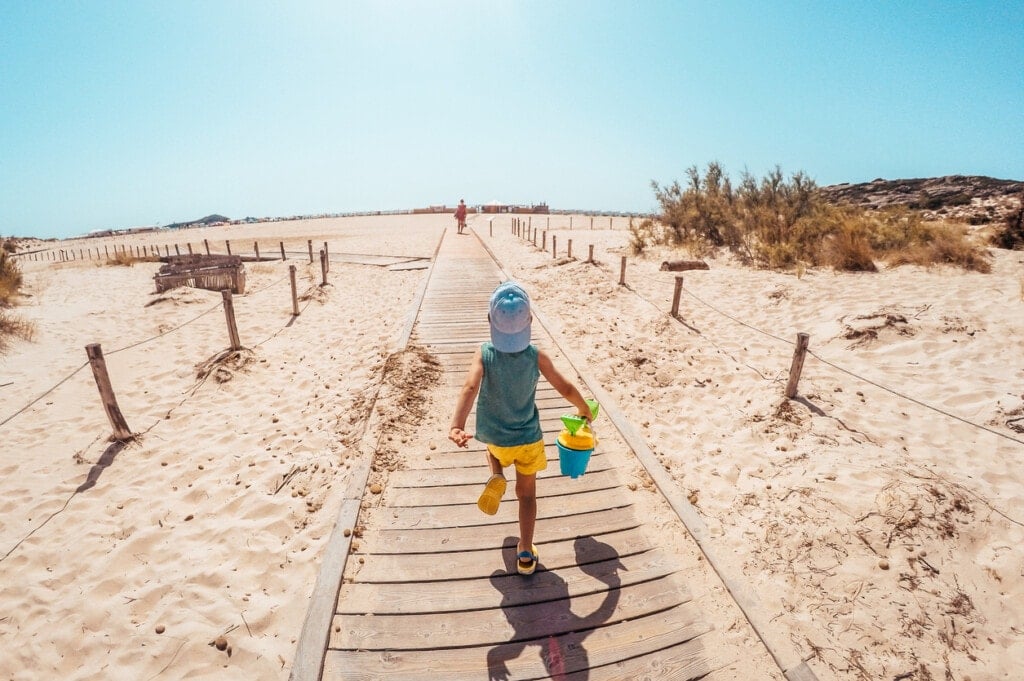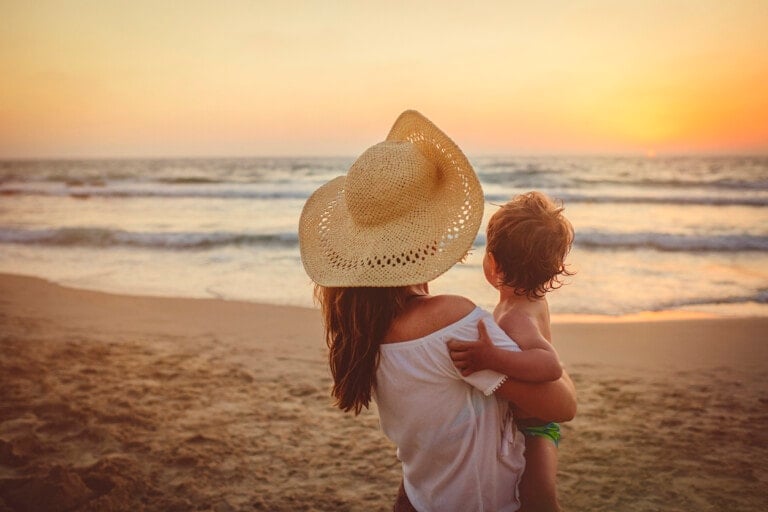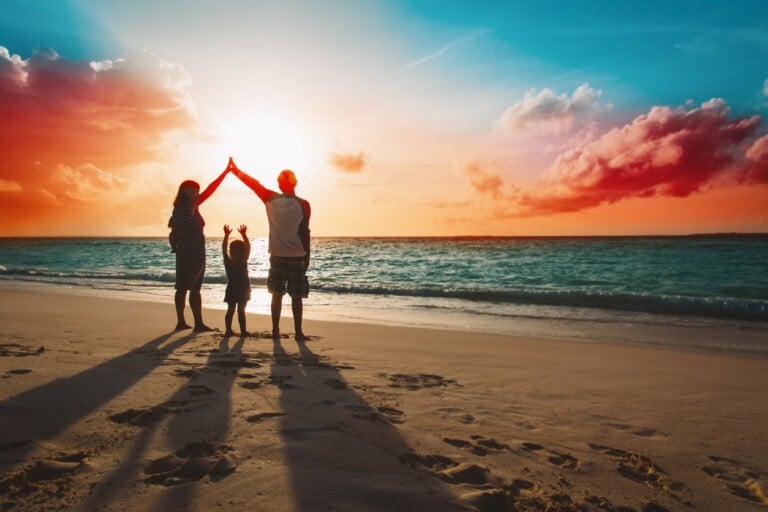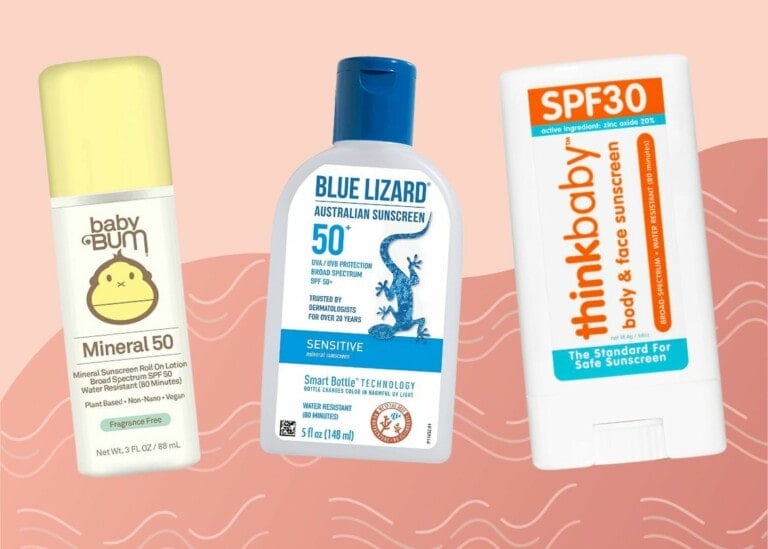Beach safety is critical to teaching kids situational awareness and to be in tune with their bodies, feelings, and boundaries. These life skills will stretch far beyond summer days and lessons that can spill into various aspects of their lives as they learn about actions, consequences, and responsible decisions. Below, we’ll explore some steps you can take to start teaching your kids about beach safety for the summer season.
How to Teach Kids About Beach Safety
Here are eight ways to teach your children about beach safety and how to get ready for summer break.
1. Enroll Kids in a Local Swim Class
Swimming lessons are a great introduction to water and beach safety, regardless of age. Even though a calm, controlled environment like a public pool is no match for the unpredictability of an ocean setting, it’s still a helpful way to get kids comfortable in the water and learn essential water safety tips. Signing your kids up for swimming lessons before a beach trip will help them become more comfortable in the water, learn crucial skills like floating and gliding, and enhance their overall water safety. According to research published by the National Institutes of Health, formal swimming lessons can reduce the risk of drowning by 88% in children.1,2
2. Always Visit a Lifeguarded Area
Make it a point to visit lifeguarded areas when visiting the beach with your family. The chances of drowning at a beach with lifeguards are incredibly low, approximately 1 in 18 million. When it comes to lifeguarded beaches, it’s also essential for parents to become aware of the signs and the flags and what they mean. Did you know a green flag indicates that calm water conditions make swimming safe, whereas a purple flag warns of dangerous marine life, like jellyfish, stingrays, or sharks?
Read the signs upon arrival to learn the hazards specific to the beach you’re visiting or local regulations you might not know. Be mindful of the flags flown by lifeguards, which advise swimmers about hazards and temporary restrictions. The best bet? Take a minute before unpacking what probably feels like a quarter of your home and check in with the lifeguard on duty whenever a warning flag is flown. Here are common flags approved by the International Lifesaving Federation and endorsed by the United States Lifesaving Association.3,4
3. Teach Kids Beach Safety Means Never Swimming Alone
This seems obvious, but as you prepare for your beach trip, ensure there is always a designated “water watcher,” whether you, a spouse, or a grandparent who will always have eyes on your kids. Regardless of your age or level of swimming skills, it’s never wise to swim alone, so also be sure to model this behavior for your little ones when you head out to the water.
Young children or inexperienced swimmers should always be within arm’s reach of an adult. While a water watcher is not a substitute for a lifeguard, it can be a lifesaving extra step to keep the whole family safe. Also, distractions abound at the beach, from the sights and sounds of endless people and nature watching to the temptation of a cold cocktail or mindless social media scroll. The best supervision is sober, cell phone-free watching.5
4. Be Aware of the Weather
Weather and water conditions can change quickly, so it’s important to heed warnings as you’re preparing for a beach trip. Before leaving, check the official surf zone forecast, beach advisories, and closings. Thunderstorms, tropical storms, and hurricanes far out at sea can create dangerous waves and currents at the shorelines of a beach, even on a sunny day. Some small waves can hit you with the force of a car, and getting knocked down or pinned to the sand can cause serious injury. Watch the sky for darkening clouds, sudden changes in wind patterns, or a significant drop in temperature, as these may indicate an approaching storm. If you notice signs of poor weather ahead, it’s time to pack up and get indoors.6,7
5. Teach Children About Ocean Tides and Beach Safety
Responsible for most rescues performed by lifeguards, rip currents can form in any large open water area, such as low spots and breaks in sandbars, or near structures such as jetties and piers. Parents should check conditions before entering the water and be aware of danger signs. If you’re uncertain, ask a lifeguard about water conditions, beach conditions, and potential hazards. Staying at least 100 feet from piers and jetties is advisable when in the ocean, as rip currents commonly occur near these structures. Practice a water emergency plan with your kids before entering the water. Explain to them that if you are caught in a rip current, the best thing to do is to stay calm and not fight it; instead, swim parallel to the shore until you are out of the current, then turn and swim to shore.8
Alternately, you can demonstrate or explain to your kids that they can float or tread water until a rip current subsides, and then they can safely head to shore. As a last resort, if making it to shore is not an option, teach your kids to draw attention to themselves by waving and calling for help.8,9
6. Stay Hydrated
Water makes up about 60 percent of the human body. Even without the additional elements of a beach setting, we’re constantly losing water through urine, sweat, and breathing. Saltwater can result in dehydration which can creep up on us and our little ones, especially while enjoying the summer sun. Dehydration-induced cramps, dizziness, and other related symptoms can be hazardous for kids while swimming. So, bring plenty of water and monitor that your kids drink regularly to stay hydrated.10,11
According to medical recommendations, children should aim to drink a number of 8-ounce glasses of water equivalent to their age each day until they turn eight years old. Children 8 and older should drink eight 8-ounce glasses of water per day. So, if you have a 6-year-old, they should be getting six 8-ounce glasses per day. Although this might seem like a lot when considering a 10-year-old should be drinking eight 8-ounce glasses a day, this can easily be accomplished by drinking water with meals.11
7. Teach Heat Safety
There’s nothing like reveling in the fun of the sun, especially after seemingly endless months of cold. But too much of a good thing can be dangerous, especially for little ones, so it’s important to teach kids about heat and sun safety. Overexposure can cause serious health effects, including skin cancer and other skin disorders, eye damage and cataracts, and immune system suppression. According to the EPA, unprotected exposure to the sun during youth puts children at increased lifetime risk for skin cancer. One or two blistering sunburns in childhood may double the lifetime risk of developing melanoma.12
Parents should always keep babies under six months out of the sun; their skin is too sensitive for either sun or sunscreen. Their heads and faces can be covered with a wide-brimmed hat, a waterproof long-sleeve rash guard, and sunglasses to protect young kids better. It’s also wise to limit their time in the sun, especially between 10 a.m. and 4 p.m., so build in breaks while at the beach for some shady time under the umbrella. Think snack time, storytime, or even an ice cream treat break to get some relief from the heat. Be aware of how often you’re applying sunscreen to your kids and make sure older kids apply sunscreen regularly, too.12
8. Teach Beach Emergency Preparedness
As a part of beach safety, teach your kids the importance of preparing for any potential emergencies, especially in a remote outdoor setting. Having basic first aid knowledge and a well-stocked beach safety kit can make a significant difference if an accident occurs. You can even involve your kids in stocking when you’re creating a kit so they can help and ask questions. Include bandages, antiseptic wipes, tweezers for removing splinters or stingers, and a small supply of necessary personal medications.
Are you traveling to a new beach destination? Familiarize yourself with local emergency protocols, contact information for lifeguards, local authorities, and nearby medical facilities. Additionally, educate yourself and your family about the signs and symptoms of common beach-related injuries, like heatstroke, jellyfish stings, or cuts from sharp objects. Knowing how to respond appropriately in these situations can help minimize further injury and ensure the well-being of everyone.
As you gear up for the summer and plan your next beach outings with your kids, remember that beach safety is paramount. The beach offers a world of wonder and beauty, but as parents, it’s our responsibility to ensure our kids can enjoy it safely. So, embrace the sandy shores, cherish the crashing waves, and savor the joy of the beach while keeping your family’s safety at the forefront. Beach adventures await!






























